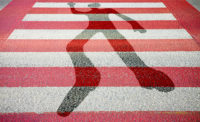Are angry voters a safety risk?

As if you haven’t noticed, this is the year of The Angry Voter. Google the phrase “angry voters” and you get about 35,800,000 results. “To be a citizen means to specialize in the venting of spleen,” The New York Times recently reported.
And who are the angry voters? Embittered working-class white males, it’s often said. But frustrations go beyond blue collars. A CNN/ORC poll in December 2015 suggested 69 percent of Americans are either “very angry” or “somewhat angry” about “the way things are going” in the United States. And across the board they’re getting angrier. Another poll found 61 percent of Republicans, 54 percent of white Americans, 42 percent of Democrats, 43 percent of Latinos and 33 percent of African-Americans are more dissatisfied and angry than they were a year ago.
Driving the rebellion
Why the outrage? Pundits point to several reasons why, as one report says, “the American Dream is in tatters”: 1) Household incomes generally have stagnated for the past 15 years; 2) There is a sense that many jobs are of lower quality and opportunity is dwindling; 3) Many older voters in particular don’t recognize the country they grew up in – 40 years ago 84 percent of the American population consisted of non-Hispanic white people; last year the figure was 62 percent; it’s predicted to drop to 46 percent by 2065, according to Pew Research. Nearly 56 million immigrants have arrived in the U.S. since 1965. 4) The Federal Government is viewed as impotent, incompetent, untrustworthy and a failure; 5) Americans don’t feel safe – they are more afraid of terrorism than at any time since 9/11; and 6) People have become more hardened in their social, economic and political views – both to the right and left; a Pew study found many Americans would be unhappy if a close relative married someone of a different political persuasion
Is there a connection?
So what does an angry populace have to do with workplace safety?
Perhaps nothing. Or maybe it raises at-risk behavior. The connection might be a real stretch. Or a real problem. Let’s consider it.
Take road rage. Stress and emotions have a serious effect on driving. If you are worried, upset, frightened or depressed, your driving skills can be as negatively impacted as they would be if you were engaged in an intense phone call or after having consumed several alcoholic drinks, according to DVM.org, a safety and driving website.
What if you come to work worried, upset, anxious or depressed, and your job calls for working with heavy equipment, working at heights, keeping pace with an assembly line, or working with energized equipment? Volatile emotions can distract you, make you less alert, less aware, perhaps more impulsive.
Escalating violence at work
Then there is workplace violence. Nearly two million American workers are victims of workplace violence each year. Workplace violence is any act or threat of physical violence, harassment, intimidation, or other threatening disruptive behavior that occurs at the work site. In 1992, the Centers for Disease Control and Prevention declared workplace homicide a serious public health epidemic. Workplace homicide tripled in the next decade, becoming the fastest-growing category of murder in the United States, according to research. Murder and other violent crimes have escalated in the workplace to the point that the U.S. Department of Justice proclaimed the workplace the most dangerous place to be in America.
Bottom line: angry emotions can cause problems for safety and health managers. But here’s an important distinction to make: safety and health professionals deal with angry employees on an individual basis; rare is the instance where the entire workforce is venting spleen. Then we’re talking about organized strikes and walkouts. In 2015, 12 major work stoppages idled 47,000 workers lasting one full shift or longer, according to the U.S. Bureau of Labor Statistics.
Individual vs. collective behavior
More common are problems with individual workers who turn to verbal abuse, bullying, intimidation, harassment and physical violence. And their grievances seldom are with Washington, immigration policies or income inequality. More likely, according to OSHA and experts on workplace violence, angry employees say they’ve been treated unfairly; forced to wait for a promotion, raise, etc.; show signs of mental instability; have recently been disciplined; are unhappy with low-level tasks to do; have a history of violent behavior including any involvement with the criminal justice system; are bitter and unhappy; abuse drugs or alcohol; and perhaps had problems growing up, including bad grades in school, abusive parents, etc.
Warning signals that flash before an active shooter goes on a rampage again are individualistic: stalking or written threats, paranoid ideas, delusional statements, increased isolation, changes in personality or performance, depressed mood, suicidal intent, and odd or bizarre behavior.
The Angry Voter does not exhibit odd or bizarre behavior, is not depressed nor delusional. They vent their anger to pollsters, reporters and at political rallies, not to bosses and safety and health pros.
The traditional American work ethic is hard-wired into most of us. We started working early, mowing lawns, dispatching newspapers, painting houses, earning allowances, and many of us worked part-time jobs in high school and college. Hard work, sometimes long hours and overtime, and job stress are almost expected. “It is what it is.”
Following the rules, including safety rules, and being productive are the norms. The fact is, many of us find it hard to pull away from work. Americans take less vacation time than most industrialized nations. Many take work with them when they do hit the beach or the slopes, checking emails, taking business calls, teleconferencing. The elusive work-life balance is increasingly challenging.
So no, I don’t believe the country’s angry mood translates into more risky behavior and attitudes on the job. What do you think? Email me at johnsond@bnpmedia.com.
Looking for a reprint of this article?
From high-res PDFs to custom plaques, order your copy today!






